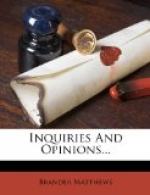“Neither in life, nor even in literature and in art, can we always do what we intend to do,” M. Brunetiere once asserted, adding that, “in compensation, we have not always intended to do all that we have actually accomplished.” Often no one is more astonished than the artist himself—be he poet or painter—at what the critics sometimes find in his work; and he is frankly unaware of any intention on his part to do all the fine things which he is told that he has done. But the critics may be justified, despite the disclaimer of the artist; and the fine things are, of a truth, to be discovered even tho they get into the work by accident, as it were, and even tho they may be the result of an intention which was either unconscious on the artist’s part, or subconscious.
We cannot help feeling the sublimity so obvious in the frescos of the Sistine Chapel; and yet it is equally obvious—if we care to look for the evidence—that while he was at this work the mind of Michelangelo was absorbed by the conquest of a host of technical difficulties. Of course, it would be going too far to assert that the great artist did not actually intend the sublimity that we admire and wonder at; but we may be sure that this sublimity is not something deliberately planned and achieved by him. It is there because the theme evoked it, and because Michelangelo was himself a man of the noblest character and of the loftiest imagination. It was inherent and latent in him, and it had to come out, inevitably and mightily, when he was engaged on a piece of work that tasked all his powers.
An ideal, a significance, a moral, that has to be inserted into a work of art and that might have been omitted, is not likely to be firmly joined; and it is liable to fall apart sooner or later. Morality, for example, is not something to be put in or left out, at the caprice of the creator; it is, as Mr. Henry James once called it, “a part of the essential richness of inspiration.” Therefore the artist need not give thought to it. If his own soul is as clean as may be, and if his vision is clear, the moral of his work may be left to take care of itself. Nearly always when an artist has been over-anxious to charge his work with a moral message, written so plain that all who run may read, he has failed to attain either of his ends, the ethical or the esthetic. There is a purpose plainly exprest in Miss Edgeworth’s ‘Moral Tales’ and in her ‘Parent’s Assistant’; and the result is that healthy girls and wholesome boys are revolted. There was no moral intent in her ever-delightful ‘Castle Rackrent’; and yet it has an ethical significance which few of its readers can have failed to feel.




